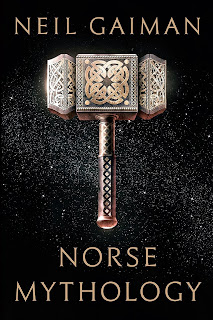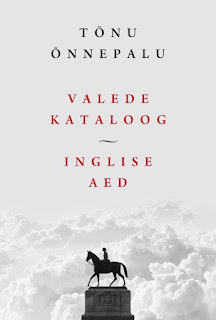Thursday Readings
Norse Mythology
Neil Gaiman6000 years ago in Sumer, at the roots of our present civilization, people worshipped Enlil, the god of air, wind, and thunder. Enlil was not a lone deity, the Sumerian pantheon had many other gods besides, but Enlil was one of the most important. In Sumer, gods and goddesses were closely associated with astronomy. Many deities were paired with specific stars or constellations. The most important gods were paired with planets of the solar system and Enlil's planet was Jupiter, which Sumerians new to be the largest planet in orbit around the Sun.
A thousand years later, Babylonian thundergod and later the main god Marduk took the place of Enlil. Marduk was, like Enlil before him, associated with the planet Jupiter.
When Ancient Greece flourished, it was Zeus, who was the god of thunder, the king of gods and the protector of the largest planet in the solar system. Naturally, that planet was then also called Zeus.
Romans followed the Greek, and it was them who gave the gods and thus also the planets the familiar names they carry today. The largest planet was renamed Jupiter and at the top of the Roman pantheon stands Jupiter, the god of thunder, lightning bolts in hand.
Roman times ended, three hundred years passed and the first Viking raids on the shores of the British Isles were recorded. Northmen came with the name of their thundergod Thor on their lips. Such was the influence of the Norsemen and their gods, that where Jupiter had been in the minds and the words of the Anglo-Saxon people, now Thor proudly stood. Has always stood.
And stands to this day. Each week, as the fifth day dawns, we invoke the name of Thor. Thursday, we say. I mentioned it as the fifth day, because in most calendar systems before 16th century or possibly even before the ISO8601 international calendar of 1988, the week begins with the day of the Sun. Sunday. The biggest, the brightest, the one in the center. Yom Rishon. Sun day. Sunday. Monday. Tuesday. Wednesday. Thursday.
Thor's Day. Many Christian Europeans would (like to) believe, that the seven-day week comes from the bible, the word of god, the Book of Genesis, the creation. In a way, it does, but it certainly did not start there.
The fifth day of the Viking week was Thor's day.
The fifth day of the week for Romans was Jupiter day (dies Jovis).
The fifth day of the week for Greek was Zeus day (hemera Dios).
The fifth day of the week for Babylonians was Marduk day.
The fifth day of the week for Sumerians was ... yes, the Enlil day. And the Sumerians, at the dawn of our present civilization 6000 years ago, came up with the seven day week and assigned the days to the Sun (Sun-day), the Moon (Mon-day) and the rest of the planets in the solar system. Jupiter. Fifth day. God of thunder. Thor. Thursday. You get the picture, right.
The Viking culture was not the first or the oldest. And it certainly wasn't standalone. It was another step in the cultural, anthropologic and migratory meanderings of mankind. I'd never read the Norse mythology before picking up the Neil Gaiman version. Why did I pick it up now? A combination of old curiosity and trust in Gaiman's superior storytelling abilities, mostly.
It starts with creation. All mythologies do. Light and darkness were separated (fire and ice, in this case), dry land with bodies of water, balmy climate, plants and animals a plenty, created for man (Midgard, in this case). Heavens (Asgard) above for the gods and Hell (Hel) below for the dead, who have to cross a river to get there, guarded by the hell-hound (Garm). Any of this sound familiar even without reading Norse mythology? :) In the Norse case, but unlike Christian creation myths, the different worlds are all interconnected by yggdrasil, the world tree. The ancient baltic myths called it ilmapuu, in Chinese mythology it's Kien-Mu, in Hindu creation myths Ashvattha etc.
Most of the rest of the book contains the lives and adventures of the gods, their relationships and feuds. Think Greek mythology, for instance.
In the final chapter (the Book of Revelation), we have Ragnarök. The Judgement Day. Yawm ad-Din. The dead arise. A final battle. Many gods are killed. The world goes up in flames and nothing but the ashes is left. Well, almost nothing. A man and a woman hide in the world tree, re-emerge once the fires have burned and repopulate Midgard with their kin. An important difference from the finality of the Christian doomsday.
Gaiman's is not a scientific approach to Norse mythology by any measure. It's a superb modern storyteller retelling us the oldest story of mankind, in it's Norse incarnation. Not a typical Neil Gaiman book, even though many of his previous works are saturated with references and characters of the Norse myths. Mr Wednesday, a case in point.
I was born in a country where Thor the thundergod was the most revered god of all. Perhaps unwittingly, but still. My birth certificate was stamped with the symbol of Mjollnir, Thor's hammer. As was my first student ID. Many other designs were proposed in the 1917 competition for Soviet symbol, including a number that featured tools or weapons (the wrench, for example, and the sword). Yevgeny Kamzolkin, author of the winning design, has not explicitly written why he chose to cross the sickle and the hammer on the coat of arms, that went on to become the national emblem of the Soviet Union. We do know, that it was Lenin himself, who dropped the sword and picked the hammer. But the rich and ancient symbolism (the red star, the rising sun) of Kamzolkin's design indicates, that the university-educated artist was no doubt aware of the semiotic meanings behind his chosen devices, including the hammer, which as a symbol of the industrial proletariat and the industry in general goes back to Slavic god Svarog, the hammer-holding god, the protector of blacksmiths, the god of heavenly fire.
"Neil Gaiman’s retelling of the Norse mythology corpus is thoroughly modern, audacious and distinctly novelistic," writes another reviewer. Ditto. It's a story, it's all just a story.



Comments
Post a Comment